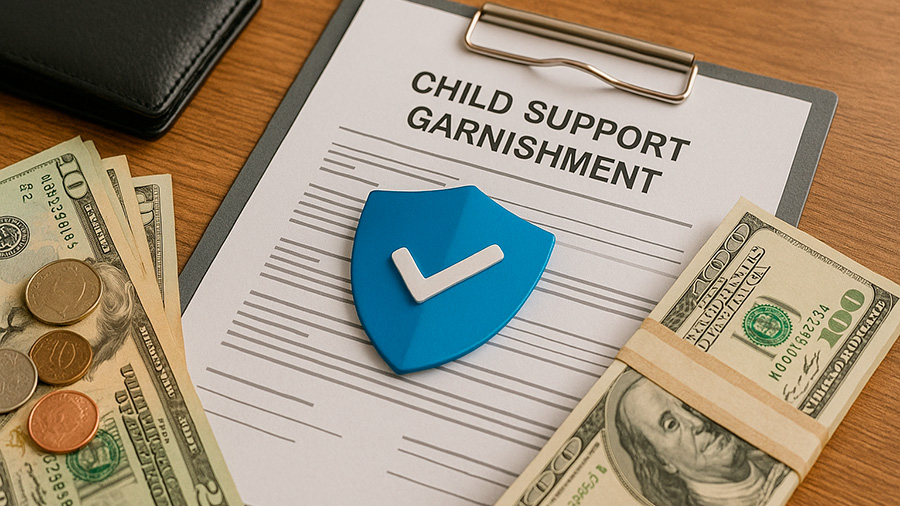
Few financial topics combine legal structure and emotional complexity quite like child support. It is both a moral and legal obligation, ensuring that children continue to receive financial care even when parents live apart. But what happens when those payments are missed, or when they must be enforced through an employer or financial institution? That’s where an explanation of child support garnishment rules becomes essential. This system, often misunderstood, plays a vital role in guaranteeing consistent support for children while balancing the financial rights of both parents. Understanding how garnishment works, how it’s calculated, and how it affects income can help anyone facing this situation approach it with clarity and confidence.
What Is Child Support Garnishment?
Child support garnishment is the legal process by which money is automatically deducted from a person’s income to fulfill child support obligations. This is not an optional measure; it’s typically ordered by a court or a state child support enforcement agency. In most cases, employers receive a notice directing them to withhold a specific amount from the employee’s paycheck and send it directly to the appropriate state agency or the custodial parent. An explanation of child support garnishment rules begins with the simple idea that it ensures children receive the financial resources they are legally entitled to, without relying solely on voluntary payments.
How the Garnishment Process Begins
Garnishment usually begins after a court order is issued or when a state child support agency intervenes to enforce a delinquent account. Once the order is finalized, the employer is legally required to comply. The order specifies how much should be withheld from each paycheck and where the funds should go. In some cases, child support can also be taken from other sources of income, including bonuses, commissions, unemployment benefits, and even tax refunds. This automatic system ensures that payments are made consistently and that both parents maintain accountability. An explanation of child support garnishment rules shows that the goal isn’t punishment—it’s reliability.
Table: Common Sources of Income Subject to Garnishment
| Income Type | Subject to Garnishment? | Notes |
|---|---|---|
| Wages and Salaries | Yes | Most common source of child support payments |
| Bonuses and Commissions | Yes | Included as part of gross income |
| Unemployment Benefits | Yes | State agencies can deduct from benefits directly |
| Tax Refunds | Yes | Intercepted through federal and state refund offset programs |
| Social Security Income (SSI) | No | SSI is protected, but Social Security Disability (SSDI) can be garnished |
How Much Can Be Garnished?
The amount that can be garnished depends on federal and state laws, which set strict limits to protect the noncustodial parent’s ability to meet basic living needs. According to the U.S. Consumer Credit Protection Act (CCPA), up to 50% of disposable income can be withheld if the person supports another spouse or child, and up to 60% if not. If payments are more than 12 weeks behind, an additional 5% can be added. “Disposable income” means what remains after legally required deductions like taxes and Social Security contributions. An explanation of child support garnishment rules also clarifies that these percentages apply per paycheck, meaning the process continues until the debt or current obligation is satisfied.
Real-Life Example: How Garnishment Affects Pay
Consider Daniel, a warehouse employee earning $4,000 a month after taxes and deductions. He owes $700 monthly in child support but has fallen behind by two months. Under federal guidelines, the court orders 60% of his disposable income to be withheld until he catches up. That means $2,400 per month is sent directly to the state agency. Daniel still takes home $1,600. Though challenging, this automatic process ensures that his children receive what they are owed while creating a structured way for him to repay his arrears. This example illustrates the fairness behind an explanation of child support garnishment rules: it prioritizes children’s needs while maintaining a financial floor for the parent.

How Employers Handle Child Support Orders
Employers play a key role in enforcement. Once a garnishment notice is received, they must begin deductions within the next pay cycle. They are prohibited from firing, disciplining, or discriminating against employees because of child support obligations. Employers must also remit the withheld amount promptly to the proper state or county office. Failure to comply can result in penalties for the company. Most modern payroll systems handle these deductions automatically, ensuring accuracy and compliance. An explanation of child support garnishment rules reminds both employers and employees that cooperation is essential—this process runs smoothly when both sides fulfill their responsibilities.
Table: Key Responsibilities of Employers and Employees
| Party | Responsibility | Potential Consequence for Non-Compliance |
|---|---|---|
| Employer | Deduct and forward payments accurately and on time | Fines, penalties, or court action |
| Employee (Obligor) | Ensure employment and contact info are up to date | Additional enforcement actions, possible license suspension |
| State Agency | Monitor payments and enforce compliance | Legal remedies against employer or obligor |
When Garnishment Extends Beyond Wages
In some cases, if wage garnishment doesn’t cover the full debt—especially when arrears are substantial—state agencies can pursue additional measures. These may include intercepting tax refunds, placing liens on property, or seizing funds from bank accounts. In rare circumstances, courts can even suspend driver’s or professional licenses to enforce payment. These actions usually come after multiple missed payments or avoidance attempts. While such measures may seem harsh, an explanation of child support garnishment rules highlights that they exist to uphold a legal and ethical responsibility: ensuring children do not suffer due to unpaid support.
Exceptions and Protections
Not every source of income can be garnished. Federal benefits like Supplemental Security Income (SSI), veterans’ benefits, and certain disability payments are generally protected. However, some of these exemptions vary by state. If someone believes their income was wrongfully garnished, they can file a claim of exemption with the court or the state child support agency. It’s also possible to request a modification of the support order if financial circumstances change—such as job loss or medical emergencies. An explanation of child support garnishment rules always involves understanding your rights as well as your obligations.
How Child Support Garnishment Differs From Other Types
Child support garnishment has higher priority than most other wage deductions. Unlike credit card judgments or personal loan collections, it takes precedence over nearly all debts except federal tax obligations. Employers must process child support orders before any other voluntary or court-ordered garnishments. This ensures that child support payments remain consistent even when the obligor faces multiple financial pressures. It also explains why some individuals notice larger deductions after additional garnishments are applied—child support always comes first.
Real Example: Multiple Garnishments at Once
Maria, a nurse in Texas, owed $1,200 in child support and had a $500 wage garnishment for a student loan default. Federal law capped her total deductions at 65% of disposable income. Because child support has priority, her entire $1,200 obligation was deducted first, leaving only $200 available for the student loan garnishment. This kind of case demonstrates how carefully structured an explanation of child support garnishment rules must be—every deduction follows a legal order of importance.
How to Stop or Reduce Garnishment
Stopping child support garnishment isn’t about avoiding responsibility—it’s about ensuring the amount reflects your current financial situation. To modify or end a garnishment order, you must request a review from the issuing court or state agency. Valid reasons include a loss of income, a change in custody arrangements, or the child reaching legal adulthood. Courts review evidence, such as pay stubs or tax filings, before adjusting the order. Ignoring the issue only worsens financial strain. Communicating proactively with both your employer and the child support agency keeps things manageable and transparent.
Financial Planning While Under Garnishment
Managing money while part of your income is garnished can be stressful but not impossible. Creating a strict budget helps regain control. Prioritize essential expenses—rent, utilities, food—and reduce discretionary spending. Building a small emergency fund can prevent new debts from forming. Many people find it helpful to work with financial counselors who specialize in family and debt management. Over time, consistent compliance with garnishment orders improves creditworthiness, demonstrating reliability to lenders and future employers. The lessons learned during an explanation of child support garnishment rules often lead to better financial habits and long-term stability.
How Technology Is Simplifying the Process
In recent years, digital tools have streamlined child support payments. Many states now operate online portals where parents can track payment history, view balances, and make direct deposits. Employers also submit withholdings electronically, reducing delays. Automated systems minimize human error and ensure funds reach children faster. For parents managing multiple obligations, these platforms offer much-needed transparency and organization. As an explanation of child support garnishment rules continues to evolve, technology plays an ever-larger role in ensuring fairness and efficiency.
Long-Term Impacts of Compliance
Complying with child support orders does more than meet legal requirements—it rebuilds trust. Timely payments help maintain healthy co-parenting relationships and create stability for children. From a financial standpoint, compliance prevents additional penalties and helps improve credit standing. Many credit reporting agencies now exclude fully paid garnishment accounts after consistent payment. In this sense, following an explanation of child support garnishment rules benefits everyone involved: the custodial parent receives steady support, the child’s needs are met, and the paying parent restores financial credibility.
